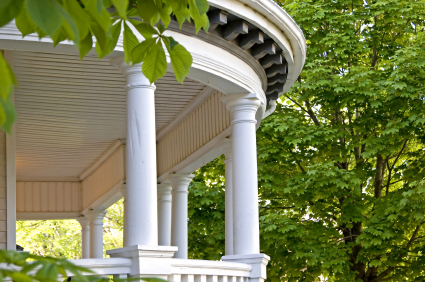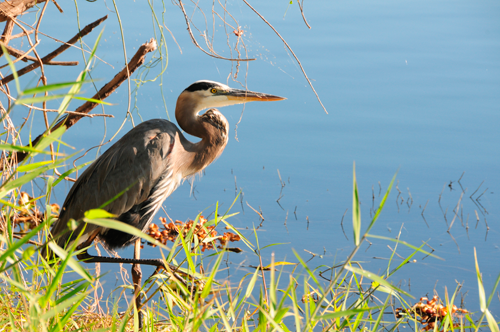
by Alex A. Kecskes
Summer’s finally here and you’re ready to invite friends, family and neighbors to your patio for a fun-filled BBQ. The last thing you need is bird poop all over your BBQ, patio cover, balcony and walkways. Or to have annoying birds dive bomb your gests and kids as they try to enjoy their outdoor summer treats.
Yes, there are bird poisons and you could whip out your trusty BB gun. But do you really want to subject kids and pets to such extreme, potentially hazardous measures? Also keep in mind that in many states and municipalities, it’s against the law to kill or harm certain birds. Banging pots and pans and shooting off firecrackers will scare birds away—but only for a little while. Unless you use permanent and effective bird control measures, they’ll come back in droves when they get a whiff of your outdoor cooking.
Fortunately, there are a number of effective bird proofing devices that will keep pest birds away from your patio and balcony. Measures you can employ without risking injury to kids, birds or pets. They include:
Visual Scare Deterrents. These are fairly economical and easy to attach to various areas of your balcony, patio, or gazebo. They include a variety of flash tape and reflective banners that reflect sunlight and crackle in the breeze. The audio/visual elements combine to create a distraction that makes pest birds feel uneasy. You can also get Bird Scare Balloons—beach ball sized bird deterrents emblazoned with large predator eyes. Birds really feel uncomfortable with these. Likewise for Bird Scare Diverters, which are bladder shaped deterrents that have a large eye on them. Remember that birds are not dummies, so you’ll need to move them around occasionally to prevent the little critters from getting used to them.
Bird Sonics. These time-proven bird deterrents can be discretely installed on patio covers, under eaves or and inside gazebos. They can keep pest birds away from large outdoor areas by emitting predator and distress calls that birds instinctively hate. They capitalize on a bird's innate fear of predators, as well as their acutely sensitive hearing (birds can process sounds in 1/200th of a second; humans process sounds in 1/20th of a second).
Sonic devices will guard your patio and balcony against pigeons, crows, starlings, swallows, gulls, woodpeckers, sparrows, grackles, cormorants and many other types of birds. One of the most effective sonic systems broadcasts the sound of Peregrine falcons (a pigeon's dreaded enemy) defending their territory. Other systems will deter starlings and seagulls with the sounds of predator hawks screeching and gulls under attack. Try to get sonic bird control systems that alter the pitch, frequency, timing and intensity of the sounds they emit. You don’t want pest birds to get used to hearing the same sound over and over. One highly regarded system emits distress and predator calls for as many as 22 types of birds. The calls are cycled through every fifteen minutes. One thing to keep in mind is that sonic bird deterrents will not harm birds, pets or humans. The sounds they emit are normal bird sounds.
Scarecrows. These ingenious devices are basically motion-activated sprinklers that give pest birds a hefty blast of water the second they enter the preset radius of protection. The sudden blast of water, alarming sprinkler sound and realistic looking bird head is enough to convince most birds that this is not a hospitable area. Scarecrows connect to almost any garden hose, yet they consume just 2 to 3 cups of water per blast. They cover about 1,200 square feet with a stream that reaches out 35 feet and 45 feet wide. They stand guard 24/7 for up to 6 months and deliver over 1,000 "firings" on a single 9-volt battery. You can even fine-tune their sensitivity and coverage distance. By the way, kids and dogs love to play with these devices.
Hawk Decoys. Get one or two of these decoys, strategically place them around your patio or balcony and pest birds will stay away. You’ll need to move them around and reposition them from time to time for best effect. Hawks are the natural predators of most pest birds and they hunt during the day. Be sure to get the most realistic looking bird available. And make sure they are quality fabricated of heavy-duty plastic so they stand up to the elements. Some decoys have a hollow bottom that allows them to be filled with sand for greater stability on windy days.

Many homes in the South and mid west are graced with beautiful wraparound front porches. They serve to draw friends and neighbors for long hours of conversation and relaxation. They’re also ideal for parties and other informal get-togethers.
Trouble is, these attractive gathering places also draw pest birds. Now, most people enjoy the sounds of birds in trees, but without proper bird control, birds can take over a veranda or front porch. These architectural features often have seemingly endless nooks and crannies where birds can roost and build nests. Nothing is more irritating than discovering bird droppings on a table, chairs or glider you’ve set out on the porch or veranda. Attract enough birds and you’ll face a daily cleaning chore getting rid of bird droppings.
If you’re like most nature loving people, you won’t want to harm these birds. You just want to keep them out of your front porch and off your tables and chairs. That means you naturally object to using bird poisons and other harmful bird deterrents. The good news is, there are a number of humane and highly effective bird deterrents you can use to keep birds away from specific areas of your home. These include:
No Nasty Nest
These hanging "twine" deterrents are ideal for keeping swallows away from common nesting areas. Birds of any kind will be reluctant to work their way past the twine strips and simply move on. If you've encountered swallow mud nests under the eaves and sides of your porch or veranda, this deterrent will keep them out. Every strip of No Nasty Nest features a self-adhesive back for quick installation on eaves, gables, entryways and other areas. Bird Slope
These angled, slippery PVC panels deny birds a place to land. They’re easily installed under eaves and are ideal for preventing swallows from building nests. Bird slopes can be installed on almost any surface using nails, screws or glue. Bird Slope comes in a 4-foot kit that contains two 2-foot long sections of slope, two end caps and one tube of glue. Bird slope is ideal for ledges up to 6 inches wide. It also comes in several colors to blend in aesthetically with your front porch or veranda.
Hawk Decoys
Decorative and functional, Red-Tailed Hawk decoys convince birds that their natural enemy is on the premises. Place one or two in “problem areas” and birds will stay away. Perfect for use in porches and verandas, Hawk Decoys are easily placed or hung in conspicuous areas to discourage pest birds. Birds will communicate with each other and spread the word that your porch or veranda is “occupied” by a predator. Be sure to choose a high quality decoy made of heavy-duty plastic, as it will remain realistic looking after years of outdoor exposure. For best results, be sure to move the decoy around often to ensure bids don’t get used to it.

by Alex A. Kecskes
If you own a home near the ocean, river, pond, or lake, you may have had a run in with blue herons. These tall, light blue-grey birds have long black legs, pointed beaks, black bellies, and a black stripe along their white heads.
While they may be beautiful to look at, they can present a nuisance to your property. If you have a Koi pond, for example, you and your Koi may not be too happy to see them. For in addition to amphibians, invertebrates, reptiles, birds, and small mammals, blue herons enjoy feasting on fish.
If blue herons are giving you the blues, here are some humane and effective bird deterrents the pros use:
Bird Spiders
Like most birds, blue herons don’t like spindly things that can strike their legs as they attempt to land. Bird Spiders have long tentacles that whip erratically in the breeze to make birds too nervous to land on rooftops or fence lines. Bird spiders are easy to set up on just about any even surface. The devices come in 2-, 4-, 6- and 8-foot diameter arm lengths to create ever widening zones of deterrence. The best bird spiders come with a glue-on base, so you can easily attach them to most surfaces.
Plastic Bird Netting
An easy-to-handle and install bird deterrent, Plastic Bird Netting creates a physical barrier that will keep blue herons from specific areas of your home. The netting is typically sold in two roll sizes: 14 x 100 feet and 14 x 200 feet. You’ll want a relatively large mesh to block out herons. You’ll also want to invest in high quality, durable, U.V.-protected polypropylene netting, which is strong, light and virtually invisible. Nowadays, bird netting even comes in various colors to blend in with your home.
Solar-Powered Bird Repellers
Equipped with motor-driven “arms” that spin around continuously at 30 RPM, Solar-Powered Bird Repellers make it really rough for herons to land anywhere near them. You can easily position these repellers wherever herons gather most often. The best bird repellers come with adjustable arms that protect up to a 5-foot diameter area. And while they are solar powered, the best devices will also run at night or on overcast days, since they can store the sun's energy for later use.
Scarecrow Bird Deterrents
A silent sentry that springs to life the second a blue heron enters its radius of protection, Scarecrows do a convincing job of keeping birds away from your home. The motion-activated devices greet herons with a harmless water blast, startling sprinkler sound, and realistic looking bird-like moving head. Scarecrows connect easily to your average garden hose and will protect a 1,200 square foot area that extends 35 feet out by 45 feet wide. The best scarecrows will deliver up to 1,000 "firings" on a single 9-volt battery, and you can adjust their sensitivity and range.
|



 RSS Feed
RSS Feed